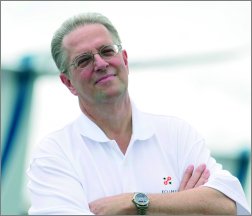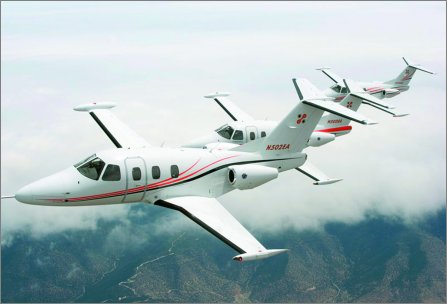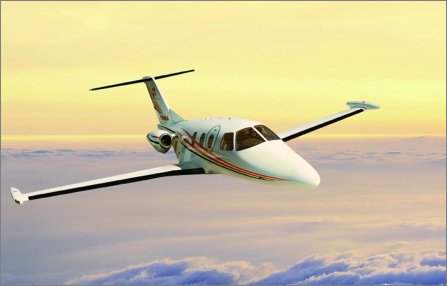 Eclipse Aviation founder Vern Raburn explains why he still dreams of making business jet travel accessible to millions
Eclipse Aviation founder Vern Raburn explains why he still dreams of making business jet travel accessible to millions
With the Eclipse 500 heading for certification in June, the first production aircraft rolling through the factory and 2,400 orders in the bag, Vern Raburn’s much-derided dream of building an affordable very-light jet with the potential to revolutionise corporate aviation is about to be realised.
It has been a turbulent journey for the 6,500-hour private pilot and former IT high-flyer who, in the late 1990s, persuaded investors to back his vision of a twin-engine, glass-cockpit, single-pilot corporate jet – selling at the price of a piston – to the tune of almost half a billion dollars.
Last week, at Singapore’s Asian Aerospace, Raburn celebrated his latest honour: the Publisher’s Award in the inaugural Flight International Aviation Excellence Awards in recognition of his contribution to aviation. It followed the prestigious Collier Trophy for the Eclipse 500 earlier this month.
But three and a half years ago, the cynics who doubted Raburn’s maths and his determination to volume-produce aircraft using methods unheard of in the general aviation sector – including massive outsourcing and automotive-style just-in-time production – were getting their “told you so” speeches ready.
Lean machine
After flying a prototype in late 2002, Albuquerque-based Eclipse Aviation was forced to ditch the Williams EJ22 engines and go back to the drawing board. The sceptics smirked. This outsider had run up against the old industry realities; Raburn could talk about breaking the mould and creating a new market niche, but had not reckoned with handling awkward suppliers, the Federal Aviation Administration and the hard economics of building aircraft.
|
| Triple Eclipse: The aircraft is selling for a third of the price tag normally associated with entry-level jets |
Today it is those doubters, particularly from established aviation manufacturers, that look worried. Eclipse has taken more than $3 billion worth of orders secured with non-refundable deposits. The first of the Pratt & Whitney Canada PW610F-powered aircraft flew on the last day of 2004 and there are now five Eclipses in flight test.
What is more, its Albuquerque, New Mexico plant – though modest compared with Cessna’s or Bombardier’s – is employing design, engineering and production techniques never before seen in general aviation. These include using friction-stir welding rather than rivets to join panels and vastly reducing the parts count and assembly time in the factory by shipping in ready-built parts from suppliers.
This lean production system is essential to Eclipse meeting its unprecedented target of producing four aircraft a day after an initial ramp-up period. Output is booked up to 2010, although there are some delivery slots for new orders from the third quarter of 2008. But it is a production philosophy that has risks. “If a vendor doesn’t deliver a part, I can’t finish the aircraft,” says Raburn, who worked for Microsoft and Lotus before turning aviation entrepreneur. These dangers were highlighted late last year, when problems with one supplier caused certification to be delayed for three months from the end of March target, and it has prompted Eclipse to review its earlier policy of single-sourcing most of its key components.
|
The Eclipse 500 could change the way American's travel to do business |
The US aerospace industry’s failure to adjust to the sort of demands Eclipse is putting on its suppliers is a constant refrain of Raburn’s. “The vast majority of our problems are with US companies, not overseas ones,” he admits. “It all comes down to a culture of the aerospace industry. Quality has never been an issue – this is an industry for whom quality is a matter of life or death. But price is something to be negotiated after the fact and schedules are there to be broken. It’s all driven by cost-plus pricing on defence contracts which defends failure. It does nothing to incentivise efficiency.”
Taxi tactics
Raburn is a man not afraid to take on the establishment. The whole Eclipse vision, he says, is a response to the GA industry’s refusal to move with the times and address customer needs. “The GA market has been stagnant for 25 years,” he says. “We’ve gone from 18,000 deliveries to 3,000 a year between 1978 and now. We’ve lost the whole relationship between customer satisfaction and price elasticity. I have a very simple definition of value: it’s more for less. Unlike cars, TVs, PCs or mobile phones, the industry has adopted a practice of simply making their products better by increments.”
The general aviation industry is one that has “become intellectually incestuous”, he maintains. “It’s a zero sum view of the world. I came from an industry that is exactly the opposite of that.” Most of Eclipse’s investors have come from outside aviation, he says. “All the aviation people told us we can’t do it. It’s been the story of my life for eight years.”
Raburn is comfortable using the phrase very-light jet (VLJ) to define the category the Eclipse 500 falls into and he insists larger so-called VLJs – such as the Cessna Citation Mustang – are not Eclipse’s competitors (something Cessna agrees with). Rather, he says, Eclipse’s real competitors are cars. The Eclipse 500, in the hands of air taxi operators, small companies and private users, can change the way Americans travel on business, making day trips between cities poorly connected by scheduled airline services possible and even reinvigorating dying communities in rural America.
Sceptics claim Eclipse’s reliance on the nascent air taxi market makes it vulnerable. Around 1,300 of its orders are from six air taxi companies, some of which are scarcely more than paper companies. It is not something that worries Raburn, who admits he does not know how exactly the various air taxi business models will work but is convinced the concept – given the right aircraft – will take off. There have been attempts to start air taxi operations, using the likes of Pilatus PC-12s and Cessna Caravans, but Raburn says passengers remain sceptical about travelling in turboprops.
Size matters
He also believes that, to make an air taxi network viable, a company needs “scale and adequate capital. It won’t happen unless someone has the ‘cojones’ to buy hundreds of aircraft. To get the coverage, you need the network effect, the tipping point,” he says. And if one of those six air taxi customers goes bust after taking delivery of Eclipses? “We can survive. It’s no real risk. In fact, we could do with a supply of used aircraft,” he says.
Raburn is also quick to point out that almost half of Eclipse’s orders come from what might be called traditional customers – not so much large corporations, which he says have “thick hides” when it comes to innovation – but small businesses and the self-employed: 750 orders are from owner-pilots, many of them owners of ageing piston aircraft. “There are 125,000 companies in the US that turn over $10 million plus. If you are a service company and we can improve your productivity by 10%, then suddenly a $1.5 million aircraft starts to sound like a great idea,” he says. For the owner-pilot, the main attraction is the single-pilot type rating and the level of technology on board. “You have to pay $5 million to get a glass cockpit aircraft,” he says. “We are selling this for a third of the price of entry-level jets.”
Eclipse will break even at 500 deliveries a year and will be “comfortable” at 750, he says. That boils down to as few as two aircraft a day, although Raburn’s target is four. He expects Eclipse Aviation to be profitable by 2007. The aircraft’s development has been funded almost entirely by the equity raised in the early years, with some additional cash being generated from deposits. Early adopters, who took the risk with $100,000 down payments, will pick up their aircraft for $1 million. “We’re on a steep risk reduction curve, so, guess what, if you buy an aircraft today, it costs more. And guess what, you’re not going to wait six years. It’s more like two and a half,” he says.
Unfashionably, Eclipse did not go down the risk-sharing route with suppliers. “Generally speaking, we went to suppliers and asked them either for stuff that was build to print and sometimes joint development. But in almost all cases we funded the non-recurring costs,” he says. Once output cranks up, cash flow will not be a problem. “Our parts are delivered and we build the aircraft and 10 days later we get paid for it. We don’t pay our suppliers’ invoices for 20 more days. It ain’t rocket science,” he says. At the same time, the company will not be sitting on millions of dollars worth of stock. “Cessna has four inventory turns a year. We will have 30,” says Raburn.
Another stick competitors use to attack Eclipse is its lack of an aftersales network. Again, not surprisingly, Raburn dismisses this. “Cessna has 12 service centres after three decades. We will eventually have eight. At best they have a transient advantage; at worst a false advantage. Because all our parts are the same on every aircraft it will take us four hours to plug in a new windshield. It will take three days on a Mustang.”
Future vision
As for the future, Raburn has always said Eclipse would end up as a “family” of aircraft. Although he will not give details, studies are believed to focus on a smaller aircraft, where Eclipse may be vulnerable to the likes of the HondaJet or a business jet from Cirrus.
He does not believe any competition will come from larger competitors, who would not be able to make the production leap necessary to make a lower-cost small VLJ. “Cessna cannot come after us,” he says. Whether Raburn himself is around to see that new family is uncertain. He hopes to organise an IPO in the next few years to pay back his equity investors. “I need to be the guy who takes Eclipse public,” he says. “But whether I continue to be the chief executive of a company employing three, four, five thousand people...probably not. It’s not my skillset.”
MURDO MORRISON / ALBUQUERQUE
Source: Flight International















